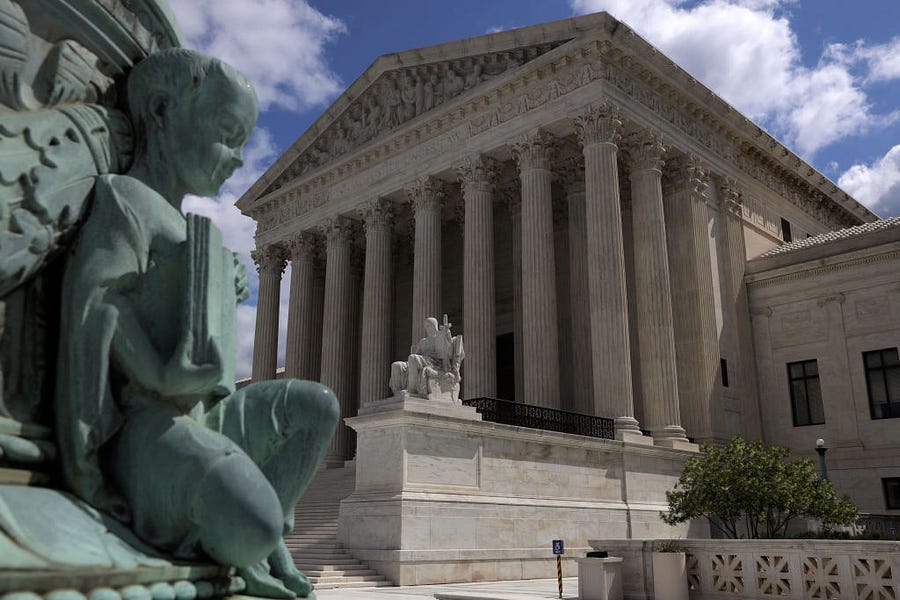A strange and counterintuitive thing is happening at the Supreme Court. At a time when SCOTUS nominating battles have polarized our nation like never before, the Court itself has defied dark partisan fears and high partisan hopes time and time again. The expected sharp ideological divisions have failed to materialize, and the Court has navigated its way through hot-button case after hot-button case through a series of supermajority decisions that have created confounding and unexpected judicial alignments.
The Court’s rulings have had profound cultural and legal consequences. In a time of deep polarization, the Court remains largely trusted by partisans on both sides—60 percent of Republicans and 67 percent of Democrats trust SCOTUS. But there’s also a legal consequence: At a time when the nation’s classical liberal order is under assault from both ends of the political spectrum, the collective effect of the court’s opinions has been to maintain a kind of “rule of reason” jurisprudence that 1) defends (and defers to) democratic processes; 2) broadly protects the Bill of Rights; and 3) disfavors discrimination and arbitrary exercises of power.
At times, given rulings have frustrated conservatives, progressives, and libertarians in turn. There are times when I’ve wanted the court to go farther than it has. (Overrule Employment Division v. Smith already!) But the three legal trends above are both unmistakable and—taken together—a (mostly) welcome and necessary defense of our nation’s classical liberal constitutional order. Let’s take each in order.
First, the defense of American democracy has most recently played out in cases that triggered Democrats’ worst fears—election challenges and Obamacare. Despite over-hyped progressive concerns (and Trump’s hopes!) that “his” judges would end Obamacare and hear Trump’s legally frivolous electoral challenges, SCOTUS supermajorities both refused to hear electoral challenges and (once again) upheld Obamacare.
The “defense of democracy” aspect of swatting aside the election challenges is obvious. Had SCOTUS overturned state election results, it might have fractured the American republic. But why bring Obamacare into this calculus? Here’s where deference to democracy applies. As I wrote last Friday, the collective effect of what Justice Alito called the Court’s “epic Affordable Care Act trilogy” is an unwritten Justice Roberts rule of jurisprudence—“When the elected branches of government enact truly significant social reforms, opponents of those reforms should focus on winning elections more than winning cases.”
In practice, the Roberts Rule means the court may strike down or limit part of the law (see, for example, the court’s decision protecting Hobby Lobby from the Obamacare contraception mandate). But if you want to end Obamacare, you’ll need to do it in Congress.
In fact, the presence of the unwritten rule is made manifest by the odd written legal contortions of the written opinions upholding the statute. It’s hard to disagree with Justice Alito’s critique:
No one can fail to be impressed by the lengths to which this Court has been willing to go to defend the ACA against all threats. A penalty is a tax. The United States is a State. And 18 States who bear costly burdens under the ACA cannot even get a foot in the door to raise a constitutional challenge. So a tax that does not tax is allowed to stand and support one of the biggest Government programs in our Nation’s history. Fans of judicial inventiveness will applaud once again.
As a matter of constitutional law and statutory construction, I have concerns with each case in the trilogy. But it seems clear that key justices (especially Justice Roberts) had one eye on the statute itself and one eye on the country and its people. At the end of the day, they were just not willing to blast apart the most significant American social legislation in a generation.
Second, the Bill of Rights is enjoying a constitutional renaissance, including in criminal cases. Consider the following (non-exhaustive) list of important outcomes.
Last week the Court protected the free speech rights of students when they speak off school grounds and outside of school activities by an 8-1 margin.
The Court also unanimously limited the ability of police officers to enter a person’s home when pursuing a person suspected of committing a misdemeanor.
Days before, the court unanimously held that the City of Philadelphia violated Catholic Social Services’ First Amendment rights when it excluded CSS from its foster care program.
Earlier, the Supreme Court unanimously held that “community caretaking” interests could not provide a categorical basis for warrantless searches of a person’s home.
In 2020, a supermajority of the Court held that jury verdicts in trials of “serious offenses” had to be unanimous to convict a criminal defendant.
Let’s go further back, to multiple additional hot-button Bill of Rights disputes.
Don’t forget that in 2018 SCOTUS ruled 7-2 for Masterpiece Cakeshop, holding that Colorado officials violated baker Jack Phillips’s First Amendment rights by targeting him on the basis of his faith when he refused to custom-design a cake to celebrate a gay wedding.
In 2017 SCOTUS ruled 7-2 in Trinity Lutheran v. Comer that government officials could not discriminate against a church when dispensing government funds for neutral and secular purposes (in this case, rubberizing playground surfaces).
And we can’t forget perhaps the most significant religious liberty case of the last three decades, Hosanna-Tabor Evangelical Lutheran Church and School v. EEOC, in which SCOTUS unanimously rejected an Obama administration attempt to apply federal anti-discrimination laws to ministerial employment.
Yes, I know that this is a partial list. Yes, I know there were contentious 5-4 Bill of Rights decisions during the same span of time (for example, NIFLA v. Becerra and Espinoza v. Montana Department of Revenue). I also know that many of the rulings above were quite narrow in scope.
But at the exact same time when Americans’ fear of polarized partisan governance is spiking, Americans’ protection from that same polarized partisan governance is increasing as well, thanks to the Supreme Court. With each passing SCOTUS term, the government enjoys less power over your individual liberty.
That brings us to the third point. The court has decreasing patience for discrimination and the arbitrary exercise of power. How do you get Justice Sotomayor, the Court’s left-most member, to side with Catholic Social Services in Fulton v. Philadelphia, a case ostensibly about the conflict between religious liberty and LGBT rights? By introducing evidence of extraordinarily arbitrary power—that a single official had the authority to exempt any institution (at his or her “sole discretion”) from the application of city nondiscrimination rules.
Moreover, in multiple cases outlined above, evidence of discrimination was indispensable to the outcome of the case. If there is a consistent thread throughout the religious liberty jurisprudence of the last 30 years, it’s that religious speech and religious exercise are not second-class forms of expression. At the very least they’re entitled to equal treatment under the law. As a general rule, when the government targets religious individuals and institutions for different (and worse) treatment than it provides secular individuals and institutions, then the government will lose.
But no discussion of discrimination is complete without the case that makes many close court observers recoil from any description of the court “holding the center”—Bostock v. Clayton County. “Wait a minute,” you might say. “Didn’t the court rewrite a federal Civil Rights statute at the stroke of a pen?”
In Bostock, as you might remember, a supermajority of the Court—led by Justice Gorsuch—held that the prohibition against discrimination on the basis of “sex” in Title VII of the Civil Rights Act of 1964 precluded employers from firing employees merely for being gay or transgender. This decision represented a striking judicial expansion of federal nondiscrimination law—an expansion indisputably beyond the legislative intent of the Congress of 1964, but arguably within the scope of the word “sex” as the definition is commonly understood.
Less than a month later, however, in Our Lady of Guadalupe School v. Morrissey-Berru, yet another supermajority of the Court limited the applicability of federal nondiscrimination law to religious institutions by expanding the scope of their “ministerial exception” to civil rights statutes. Thus (as I wrote last year in Time) the Court rendered Bostock “entirely inapplicable to tens of thousands of religious employees at thousands of religious institutions across the United States.”
Add all this together, and you begin to see that SCOTUS supermajorities have navigated, yes, a middle way. They have extended nondiscrimination protections in secular spaces, blocked targeted discrimination against people of faith, and expanded the autonomy and liberty of religious organizations.
The surprising judicial alignments are starting to raise eyebrows. Last Friday, the New York Times’s Adam Liptak quantified the Court’s majorities, and they’re nowhere close to the 6-3 conservative/liberal split we were told to expect. It turns out that Justice Kagan has joined Justices Kavanaugh, Barrett, and Gorsuch as justices who vote with the majority in divided decisions at least 80 percent of the time. Justice Alito, by contrast, voted with the majority only 36 percent of the time—a number hardly consistent with the predicted ideological split.
What is going on? If you listen to the Advisory Opinions podcast (and you should!), you’ll hear Sarah and I constantly say, “Supreme Court justices are human beings.” They are not judicial robots. They are not automatons who spit out rulings based on judicial philosophies without regard to real-world conditions and real-world impacts. Even if you faithfully hew to a particular philosophy, you’re presented with a host of choices—including whether to make a ruling narrow or broad.
One can be faithfully originalist and restrained or faithfully originalist and aggressive. And it’s rather clear that Justice Barrett, for example, has thus far mainly chosen restraint.
A history of the present court may eventually relate that the human beings at SCOTUS understood the moment. They realized that American polarization and negative partisanship had reached dangerous levels, and a majority determined that now was the time to demonstrate that consensus and compromise were indeed possible, even across yawning philosophical divides, and that that no matter the intensity (and increasing illiberalism) of political debate, that America’s classical liberal structure and values must be preserved.
I’m fully aware that this consensus may well collapse, and soon. Next term SCOTUS will hear a series of cases that touch upon virtually every third rail of American politics, including a case that could directly challenge Roe v. Wade. In fact, we could look back at the present era as something more like a pause and deep breath before a profound, polarizing plunge.
But I’m skeptical. With each new ruling, I grow more convinced that the present court is charting a path that will consistently confound fans and critics alike. The court that Donald Trump remade is so far a place of classical liberal calm in the midst of a raging partisan and populist storm.
One more thing …
If you’ve never listened to Advisory Opinions, now is the time to start. In last Thursday’s episode, Sarah and I broke down the already-legendary “angry cheerleader” SCOTUS case, and we had a great time doing it. Listen to the whole thing and tell me that legal analysis can’t be fun.
And then, once you’re hooked, tune in to yesterday’s episode to hear all about some rather spicy judicial drama. There’s a food fight at the Fifth Circuit, and it’s over one of the most consequential legal disputes in American law.
One last thing …
I have but two words: Can’t. Wait.







Please note that we at The Dispatch hold ourselves, our work, and our commenters to a higher standard than other places on the internet. We welcome comments that foster genuine debate or discussion—including comments critical of us or our work—but responses that include ad hominem attacks on fellow Dispatch members or are intended to stoke fear and anger may be moderated.
With your membership, you only have the ability to comment on The Morning Dispatch articles. Consider upgrading to join the conversation everywhere.